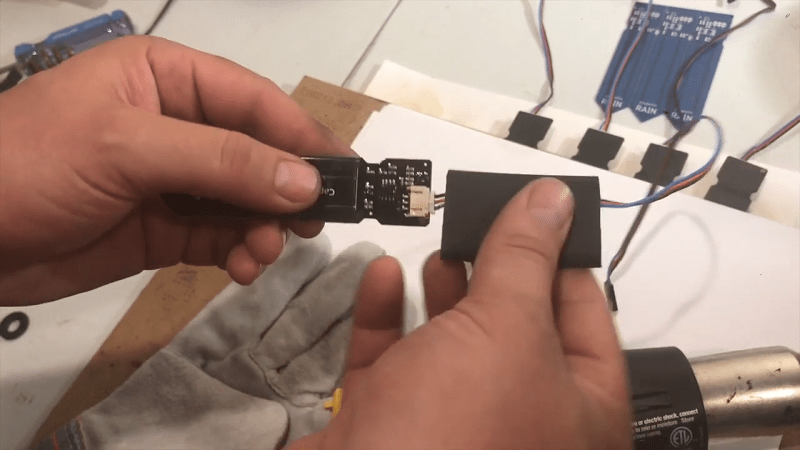[Adosia] has some interesting videos about their IoT platform controlling self-watering plant pots. However, the video that really caught our eye was the experience in sealing up sensors that are going to be out in the field. Even if you aren’t using the exact sensors, the techniques are useful.
We would have expected to see potting compound, but that’s messy and hard to use so their process is simpler. First, a few coats of clear urethane sealant goes over the electronics. Next, heat shrink goes over the assembly. It isn’t ordinary heat shrink though, instead it’s the kind that has heat-activated adhesive inside.
If you haven’t seen adhesive-lined heat shrink, it is often sold as marine heat shrink — you can even find it under that name at Harbor Freight. You also see this sometimes in tape form as heat shrinkable electrical tape.
Heat shrink seems ubiquitous and commonplace, but it is actually a fairly recent and sophisticated creation. Creating it usually requires radiation and sophisticated polymer chemistry, and it has only been available since 1962. If you do try potting instead of this technique, our advice is to avoid the silicone and stick with a proper two-part epoxy.

















In the event you don’t have any heat activated adhesive heat shrink laying around, a couple dabs of hot melt glue on the part/joint and slower heating works well too.
Definitely. I use a utility knife to shave off paper thin slices of a glue stick and pop them in the unshrunk heatshrink tube with the board/connector/wire/whatever is being wrapped.
That said, the high grade adhesive lined heat shrink tubing tends to be willing to shrink to a quarter of its unshrunk size whereas the normal stuff will only shrink to half. Someone may make the more shrinky non-adhesive stuff but if they do it’s not at any of the shops I frequent.
Mouser or Digikey has 1:4 heat shrink.
Also in the electric trade, in my region anyway, we call it glue shrink.
You can buy most common shrink tubes in the following types:
Shrinkage:
1/1.5
1/2
1/3
1/4
1/5 (never used it myself)
Glue:
Yes
No
I’ve often done this to re-use usb connectors or where space is an issue. Hot glue tends to be difficult to push through the heatshrink due to its high friction, this is greatly aided by a coating of vaseline.
I’ve injected RTV silicone into the heat shrink before heating it up. Squishes out, but easily wiped up and makes nice structural support too.
But gonna find me some of that stuff at HF.
Automotive RTV silicone gasket compound is a bad idea with electronics. The curing reaction produces acetic acid, which tends to corrode metals. I think that’s actually beneficial in gasketing applications where the acid etching the metal helps the gasket achieve a good bond.
There are non-acid-curing RTV silicones, but they’re much less common than the automotive gasket stuff.
One thing the video doesn’t mention is to make sure you gave it enough heat to properly melt the glue inside. From experience this is the point at which a small ring of the glue is pushed slightly out of the ends. If you don’t the glue may only get tacky and not fully adhere, even though it appears to have shrunk.
Benchoff says he is ambitious. And Benchoff is an honorable man.
Is the summary of the video: apply conformal coating and then wrap with glue-filled shrink-tubing?
I find it odd that he doesn’t apply the conformal coating to the sensor part, which badly needs it ’cause the printed circuit and solder mask will delaminate in moist soil. Good moisture sensors have the PCB dipped in epoxy for that reason…
They will last around a year or so without coating the capacitive trace below the board components.
The sensor will indeed function when coating the entire PCB, though a significant tradeoff in sensitivity range on wet/moist reading (low analog value) should be expected.